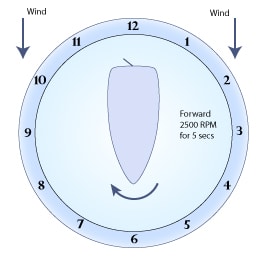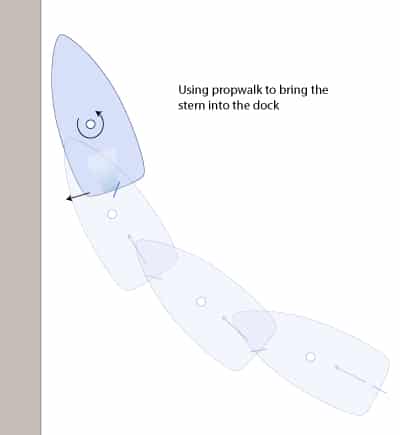Using Prop Walk
You can use prop walk to turn your boat in a tight marina by applying forward and reverse gears at appropriate times, leaving the rudder locked to starboard. This is assuming you have a right-hand screw meaning that in reverse your propwalk moves your stern to the port.
Watch this animation.
 Exercise Propwalk-2
Exercise Propwalk-2
Use propwalk to turn the boat at a minimum radius. Pretend you are in an extremely tight marina. You have little ability to go forward or backward. This exercise will show you how you can actually do a donut, and it will allow you to round out of the circle in any direction desired. With the boat facing upwind and close to a stop, put the wheel hard over to starboard and lock off the wheel. Rev the engine in forward gear to 2500 rpm for 2 seconds only.
As the boat comes around so that the wind is abeam to port, put the engine into reverse at 2300 rpm; the back of the boat will move to port and thus continue your turn. Note that in reverse you’ll find 2500 rpm probably causes a lot of vibration and is not too efficient. Better to use 2300 rpm.
Remember that the wheel stays hard over to starboard. You might think that the wheel needs to go the other way because you are in reverse, but since the boat is still slightly moving forward, water is still flowing forward over the rudder even though the engine is in reverse. And even when the boat comes to a standstill, having the rudder hard over to starboard will not affect the prop walk tendency to port
Now, as the stern of the boat goes through the wind, pump the engine back into forward to 2500 rpm. Rev the engine just long enough to prevent any forward motion but long enough to get the boat turning up through the wind to at least the 10 o’clock position so that the turning momentum will carry your bow through the wind without gaining any appreciable forward momentum.
As the bow of the boat is approaching the wind, put the engine back into reverse at 2300 rpm and watch again as the stern moves to port. You can continue this exercise until you feel comfortable. As you become an expert at this, gauge the amount of time in forward and reverse to reduce your turning circle diameter.
 What you learned:
What you learned:
The boat never gains any real forward momentum, and therefore the turning circle can be very tight. However, you are able to maintain very good control over the direction and position of the boat even with high winds.
 Note
Note
The boat has its greatest turning ability into the wind when the engine is in forward and the prop is pushing water over the rudder. The wind always wants to push the front of the boat downwind, so use reverse when the wind will work in conjunction—that is, when you want the front of the boat to go downwind during that part of the donut. In high winds, you need to pay particular attention to having the engine in forward gear between 6 o’clock and 10 o’clock. This is so that you can drive the front of the boat upwind. The port prop walk will not be enough to overcome the force of the wind wanting to push the bow downwind. In low winds, you’ll not need to concern yourself with this effect.
For a right-hand screw system, you can only do this when turning to starboard because the prop walk moves the stern to the port. Just turn the wheel to starboard and lock it off.
For a left-hand screw system, you can only do this when turning to port because the prop walk moves the stern to the starboard. Just turn the wheel to port and lock it off.
Slowing the rotational turn into the dock
When coming into the dock, as you turn the rudder to slide the boat along the dock, you are inducing a rotational turn which could bang the stern into the dock, applying reverse will create propwalk to port (for a right-hand screw). This slows the rotation of the boat and allows you to finely adjust how far the stern ends up from the dock.
Bringing the Stern into the Dock
For a scenario like the above, if you had a left-hand screw – or if you were approaching in the opposite direction this propwalk would work against you and bring the stern in closer to the dock – perhaps hitting the dock. In that case, you would finesse the operation by turning the rudder the opposite way at the last minute and using propwalk to bring the stern to the dock.
In all cases, as you gain more experience around how the rudder and propwalk work together or against each other, you can finesse each situation to your advantage. But, it comes from practice.







 What you learned:
What you learned: Note
Note




